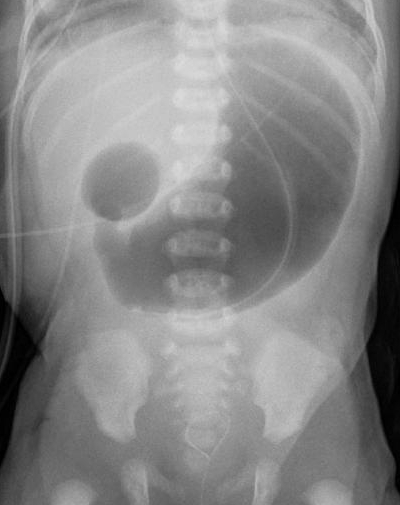Duodenal Atresia

Duodenal atresia is an embryopathy of the cranial intestine that leads to a complete absence of the duodenal lumen.
Epidemiology
The incidence of duodenal atresia is between 1/10,000 and 1/6,000 live births, with an approximately equal male to female ratio.
Clinical description
In 30-52% of infants it is an isolated anomaly, but it is often associated with other congenital abnormalities. Approximately 20 to 30% of infants with duodenal atresia are carriers of trisomy 21, and about 20 to 25% have cardiac anomalies. Other frequently described associated malformations include duodenal growth failure, annular pancreas (see this term), which are particular clinical forms of duodenal atresia, and anomalies of the biliopancreatic tract or choledochal cysts. Duodenal atresia is classified into three types: type I (duodenal diaphragm) is linked to the presence of a mucosal diaphragmatic membrane with an intact muscle wall; type II (complete a duodenal atresia) characterized by a short fibrous cord connecting the two ends of the atresic duodenum; and type III (also complete duodenal atresia) which corresponds to a complete separation of the two ends of the duodenum, sometimes together with annular pancreas. Clinical presentation depends on the degree of atresia. Important obstructions manifest during the first days of life with bilious vomiting if the obstacle is infra-vaterian, which starts in the hours after birth, and with feeding intolerance. Weight loss, dehydration, and hypochloremic metabolic alkalosis are the most common symptoms. Less severe obstructions may manifest several months, or even several years, after birth with bilious vomiting without abdominal distention (major sign); however, failure to thrive may be the only presentation.
Etiology
Vascular anomalies, abnormalities in neural cell migration and failure of recanalization of the duodenal lumen may play a causative role, although the exact cause remains unknown.
Diagnostic methods
The clinical diagnosis is confirmed by abdominal radiography that shows a characteristic 'double bubble'' appearance with air trapped in the first portion of the duodenum and stomach due to the simultaneous distension of the stomach and first portion of the duodenum (above the stenosis).
Differential diagnosis
Differential diagnoses include late appearing pyloric stenosis in cases of incomplete diaphragm, and other forms of intestinal atresia, common mesenteric intestinal volvulus, and duodenal duplication.
Antenatal diagnosis
Diagnosis is prenatal in 80-90% of cases (by ultrasound in the seventh month or before that reveals the characteristic ``double bubble'' image).
Genetic counseling
In most cases, duodenal atresia is sporadic, although an autosomal recessive pattern has been suggested in some families.
Management and treatment
Management involves neonatal resuscitation and surgical correction in the neonatal period. Post-operative complications are rare, but late complications (megaduodenum, blind loop syndrome, duodenogastric reflux, esophagitis, pancreatitis, cholecystitis and cholelithiasis) occur in very rare cases.
Prognosis
The prognosis with early surgical intervention is excellent.